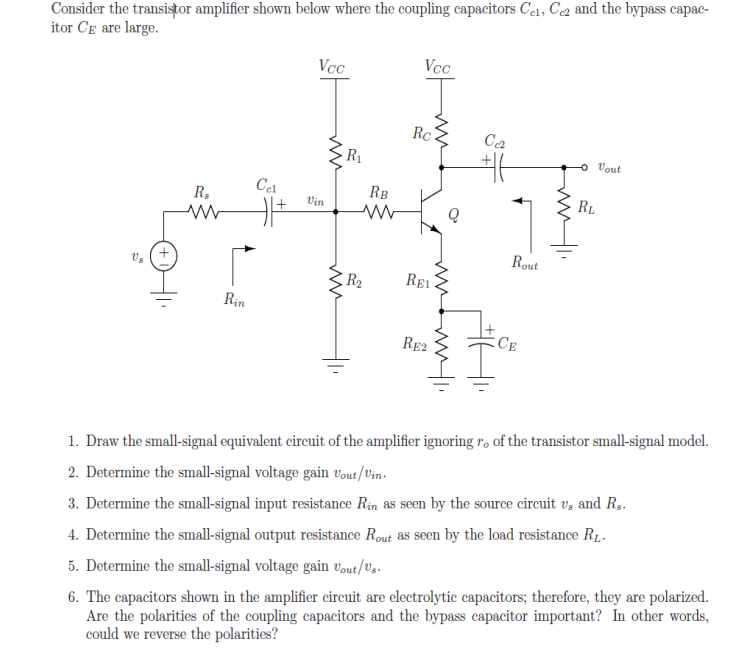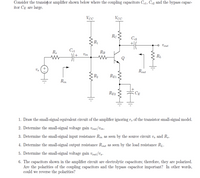Consider the transisțor amplifier shown below where the coupling capacitors Ce1, Ca and the bypass capac- itor CE are large. Vcc Vcc Rc Ca R1 Vout Cer |+ Vin R. RB RL Rout R2 REI Rin Rga CE 1. Draw the small-signal equivalent circuit of the amplifier ignoring ro of the transistor small-signal model. 2. Determine the small-signal voltage gain vout/Vin. 3. Determine the small-signal input resistance Rin as seen by the source circuit v, and R,. 4. Determine the small-signal output resistance Rout as seen by the load resistance R1. 5. Determine the small-signal voltage gain vout/Ua- 6. The capacitors shown in the amplifier circeuit are electrolytic capacitors; therefore, they are polarized. Are the polarities of the coupling capacitors and the bypass capacitor important? In other words, could we reverse the polarities?
Consider the transisțor amplifier shown below where the coupling capacitors Ce1, Ca and the bypass capac- itor CE are large. Vcc Vcc Rc Ca R1 Vout Cer |+ Vin R. RB RL Rout R2 REI Rin Rga CE 1. Draw the small-signal equivalent circuit of the amplifier ignoring ro of the transistor small-signal model. 2. Determine the small-signal voltage gain vout/Vin. 3. Determine the small-signal input resistance Rin as seen by the source circuit v, and R,. 4. Determine the small-signal output resistance Rout as seen by the load resistance R1. 5. Determine the small-signal voltage gain vout/Ua- 6. The capacitors shown in the amplifier circeuit are electrolytic capacitors; therefore, they are polarized. Are the polarities of the coupling capacitors and the bypass capacitor important? In other words, could we reverse the polarities?
Introductory Circuit Analysis (13th Edition)
13th Edition
ISBN:9780133923605
Author:Robert L. Boylestad
Publisher:Robert L. Boylestad
Chapter1: Introduction
Section: Chapter Questions
Problem 1P: Visit your local library (at school or home) and describe the extent to which it provides literature...
Related questions
Question
100%
Part 1, 2 and 3 were solved.
please solve the others.

Transcribed Image Text:Consider the transistor amplifier shown below where the coupling capacitors Col, C2 and the bypass capac-
itor CE are large.
Vcc
Vcc
Rc.
Ca
R1
Vout
RB
RL
R.
Vin
Rout
R2
RE1
Rin
RE2
CE
1. Draw the small-signal equivalent circuit of the amplifier ignoring ro of the transistor small-signal model.
2. Determine the small-signal voltage gain vout/Vin-
3. Determine the small-signal input resistance Rin as seen by the source circuit v, and R.
4. Determine the small-signal output resistance Rout as seen by the load resistance R1,-
6. The capacitors shown in the amplifier circeuit are electrolytic capacitors; therefore, they are polarized.
Are the polarities of the coupling capacitors and the bypass capacitor important? In other words,
could we reverse the polarities?
5. Determine the small-signal voltage gain vout/Ug-
Expert Solution
This question has been solved!
Explore an expertly crafted, step-by-step solution for a thorough understanding of key concepts.
Step by step
Solved in 2 steps with 1 images

Follow-up Questions
Read through expert solutions to related follow-up questions below.
Follow-up Question
some one solved it but, I think there is a mistake.
can you please just solve number 4 and 5

Transcribed Image Text:Consider the transistor amplifier shown below where the coupling capacitors Col, C2 and the bypass capac-
itor CE are large.
Vcc
Vcc
Rc.
Ca
R1
Vout
RB
RL
R.
Vin
Rout
R2
RE1
Rin
RE2
CE
1. Draw the small-signal equivalent circuit of the amplifier ignoring ro of the transistor small-signal model.
2. Determine the small-signal voltage gain vout/Vin-
3. Determine the small-signal input resistance Rin as seen by the source circuit v, and R.
4. Determine the small-signal output resistance Rout as seen by the load resistance R1,-
6. The capacitors shown in the amplifier circeuit are electrolytic capacitors; therefore, they are polarized.
Are the polarities of the coupling capacitors and the bypass capacitor important? In other words,
could we reverse the polarities?
5. Determine the small-signal voltage gain vout/Ug-
Solution
Knowledge Booster
Learn more about
Need a deep-dive on the concept behind this application? Look no further. Learn more about this topic, electrical-engineering and related others by exploring similar questions and additional content below.Recommended textbooks for you

Introductory Circuit Analysis (13th Edition)
Electrical Engineering
ISBN:
9780133923605
Author:
Robert L. Boylestad
Publisher:
PEARSON

Delmar's Standard Textbook Of Electricity
Electrical Engineering
ISBN:
9781337900348
Author:
Stephen L. Herman
Publisher:
Cengage Learning

Programmable Logic Controllers
Electrical Engineering
ISBN:
9780073373843
Author:
Frank D. Petruzella
Publisher:
McGraw-Hill Education

Introductory Circuit Analysis (13th Edition)
Electrical Engineering
ISBN:
9780133923605
Author:
Robert L. Boylestad
Publisher:
PEARSON

Delmar's Standard Textbook Of Electricity
Electrical Engineering
ISBN:
9781337900348
Author:
Stephen L. Herman
Publisher:
Cengage Learning

Programmable Logic Controllers
Electrical Engineering
ISBN:
9780073373843
Author:
Frank D. Petruzella
Publisher:
McGraw-Hill Education

Fundamentals of Electric Circuits
Electrical Engineering
ISBN:
9780078028229
Author:
Charles K Alexander, Matthew Sadiku
Publisher:
McGraw-Hill Education

Electric Circuits. (11th Edition)
Electrical Engineering
ISBN:
9780134746968
Author:
James W. Nilsson, Susan Riedel
Publisher:
PEARSON

Engineering Electromagnetics
Electrical Engineering
ISBN:
9780078028151
Author:
Hayt, William H. (william Hart), Jr, BUCK, John A.
Publisher:
Mcgraw-hill Education,